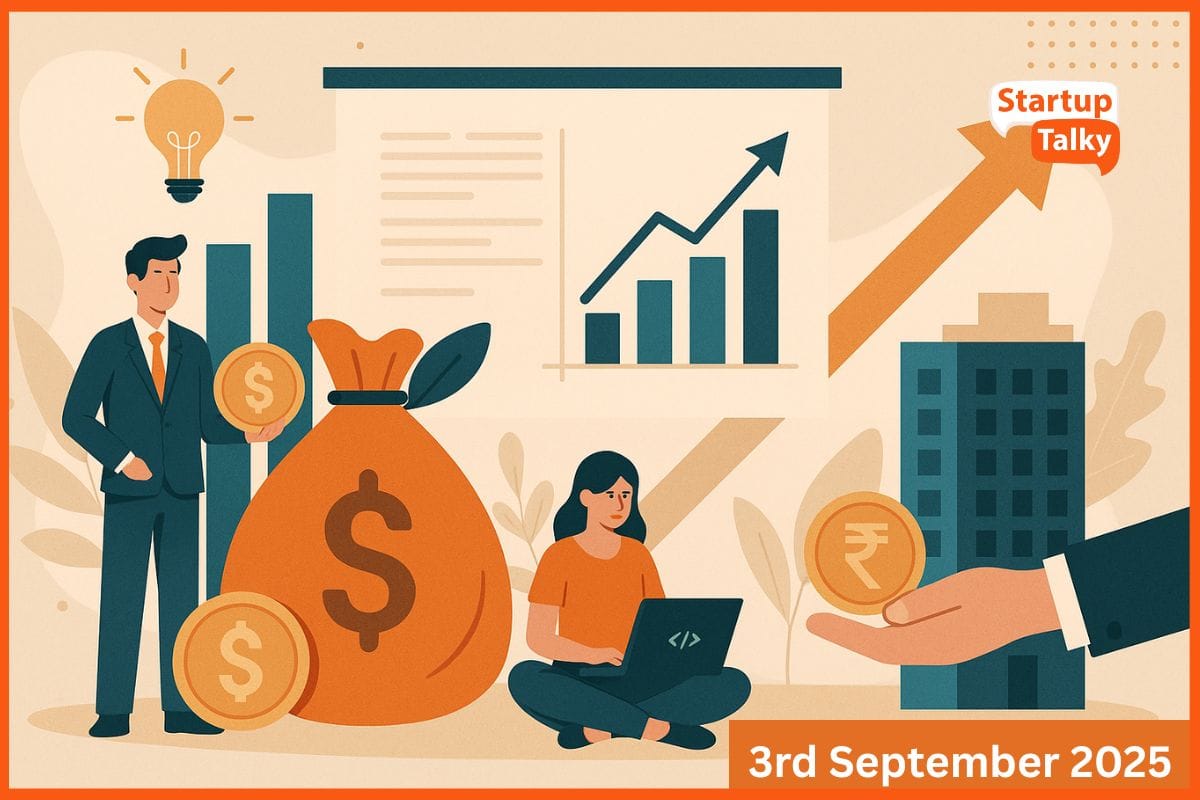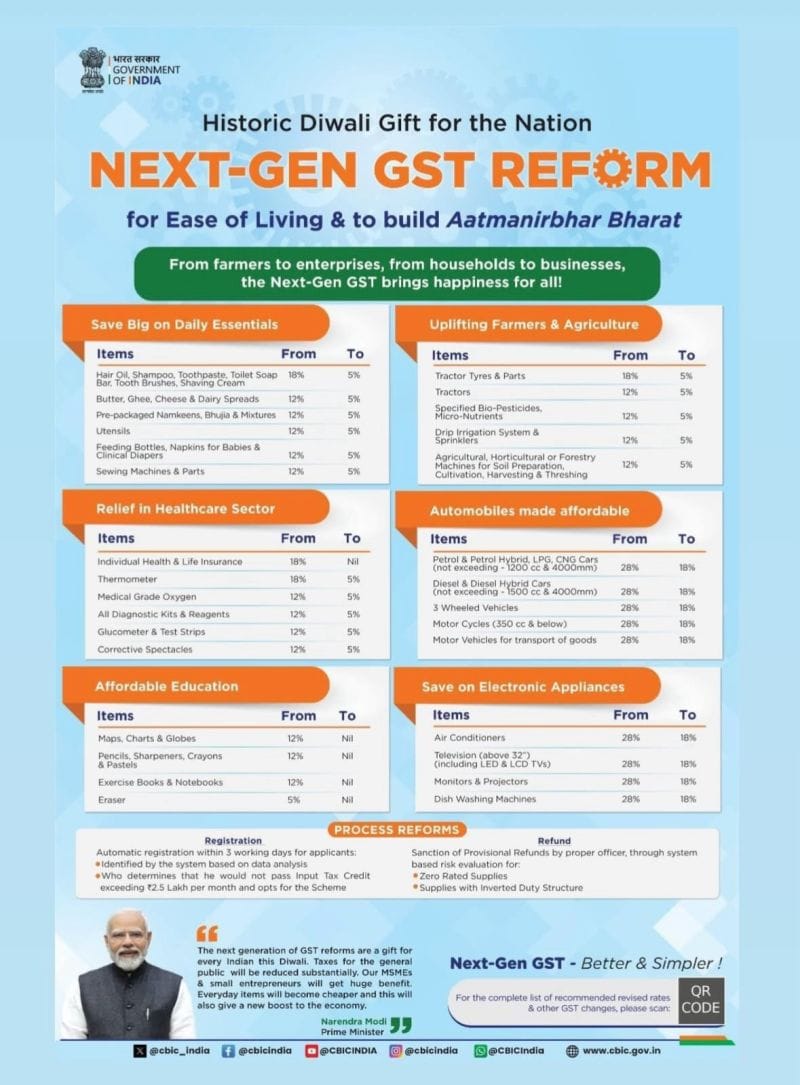As the final tax slabs were revealed on September 4, consumption stocks, which had already surged since Prime Minister Narendra Modi announced a reduction in the goods and services tax (GST) in his Independence Day speech on August 15, continued to rise.
The Nifty FMCG index has increased 4.4% since August 15th, while the Nifty 50 has increased 0.7%. Analysts anticipate that the surge will continue, supported by solid volume growth that may contribute to higher profits. However, the effects won’t only be felt in industries with high levels of consumption. According to experts, the GST drop will have an impact on logistics, banks, non-banking financial corporations (NBFCs), and other sectors that are dependent on consumer demand.
Puneett Kumar Kanojia, Founder, BollyBites VadaPav (Bollybites Foods Pvt. Ltd.) said, “The GST cut is a positive move that will especially benefit FMCG and food service businesses, including fast-growing categories like QSRs and street-food brands. In India, affordability drives consumption, and even a small reduction in effective prices can lead to higher footfall and repeat purchases. For food startups and quick-service outlets, this will not only ease pricing pressure but also enable us to pass on the benefit directly to customers, thereby strengthening consumer sentiment. Lower tax outflow also improves working capital for small and mid-sized players, allowing more reinvestment in quality, innovation, and expansion. Overall, the GST cut will act as a strong consumption booster, with ripple effects across the supply chain—right from raw material suppliers to the end consumer—ultimately supporting both growth and formalization in the sector.”
The GST Council streamlined the system on September 3rd, lowering slabs to 5% and 18% while keeping the charge at 40% for luxury and sinful items. Most categories moved to lower rates, while the 12% and 28% brackets were eliminated. Additionally, taxes on a number of necessities and staples were lowered from 18% to 5%.
Commenting on the development, Hiren Shah, Managing Director, Jyoti Global Plast Ltd. stated, “The GST Council’s reforms consolidating into two slabs of 5% and 18% alongside targeted reliefs for drones and simulators, mark a strategic inflection point for advanced industries. The sharp cut to 5% GST on unmanned aircraft and IGST exemption for simulators directly reduces costs for defence and aviation ecosystems, encouraging wider adoption and domestic manufacturing.”
“For plastics and packaging, harmonisation under the 18% slab simplifies compliance while lowering cascading effects across supply chains. The quicker registration process and seven-day refund window offer a strong boost to exporters, particularly in specialty chemicals and advanced materials, where working capital cycles are often stretched. Collectively, these reforms support scale, innovation and competitiveness across sectors critical to India’s industrial future, and we are ready to leverage our manufacturing expertise and scale to partner with emerging sectors,” he added.
How Lower GST Will Boost Auto and Electronics Demand
Reduced costs won’t encourage households to purchase more soap, oil, or shampoo, according to analysts; thus, the impact on necessities will be minimal. Discretionary items will get a greater boost.
While the demand for FMCG is comparatively inelastic, additional purchases may be prompted by a cheaper television or automobile. The demand increase would not be substantial for FMCG companies, but customers would choose to purchase well-known brands over less expensive ones because of their superior pricing, which would be advantageous to the listed FMCG companies.
The budget’s income tax cuts, a robust monsoon that boosted consumption in rural areas, and the recent GST cut all suggest a prosperous holiday season.
“The government’s decision to retain the 5% GST rate for EVs is a welcome move, as it reinforces its confidence in the industry irrespective of the segment. This continued policy support ensures that EVs remain the most tax-favored category, across both mass-market and premium offerings, allowing them to compete on the basis of technology, performance, and convenience. At the same time, the reduction in GST on ICE two-wheelers under 350cc to 18% is a balanced step that will make mobility more accessible and give the broader auto industry a healthy boost. Together, these reforms signal a positive and inclusive approach to strengthening India’s automobile ecosystem,” said Dinesh Arjun, CEO ,Cofounder, Raptee.HV
Investor Outlook Ahead of Festive Season
Investors’ recognition that reduced GST rates directly translate into better demand forecasts across consumption-linked sectors is reflected in the market’s positive reaction. As the holiday season draws near, financial institutions anticipate that “festive demand should see a positive boost” but caution about “some negative demand impact in September”.
The anticipated increase in consumption can have a multiplier effect on overall economic growth. According to analysts, the key will be how quickly businesses pass the advantages on to customers. If done correctly, this step will boost spending and sentiment.
The fact that these reforms cover everything from everyday necessities to expensive purchases explains why investors see this as a structural change rather than a short-term stimulus, which supports the widespread market rally in industries as diverse as FMCG, insurance, white goods, cement, and automobiles.
“GST 2.0 represents one of the largest reforms in taxation since the initial introduction of GST in 2017. Its implications for India’s MSMEs could be revolutionary. For many years, small companies suffered from overly complex tax structures, delays in refunds, and compliance burdens that consumed time and working capital. The new dual slab of 5% and 18% provided clarity on the classification issue and invoicing however; we are working to ameliorate classification issues,” opined Mukesh Pandey, Director of Rupyaa Paisa.
Adding further, he said, “For MSMEs this could mean less legal battles, higher efficiency and increased buyer demand as several products are now more affordably classified. India’s 6.4 crore MSMEs employing more than 11 crore people are the engine of our economy. If GST 2.0 is implemented effectively, it will not only lower the cost of compliance, but improve competitiveness and have small businesses better positioned to succeed domestically and internationally.”
|
Quick Shots
|
|
•Since PM Modi’s
Independence Day speech (Aug 15), Nifty FMCG up 4.4%, Nifty 50 up 0.7%.
•Boost expected in
FMCG, autos, electronics, logistics, banks, and NBFCs.
•Minimal impact on
necessities (soap, oil, shampoo); stronger demand for discretionary items
(cars, TVs, electronics).
•Lower GST may push
consumers toward premium FMCG brands over cheaper alternatives.
|


